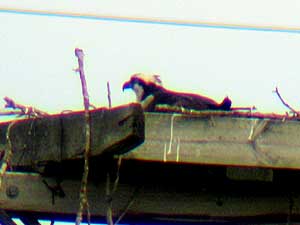|
Photos
More from MPR
Resources
Your Voice
|
First osprey count is underway in Minnesota
June 29, 2004
The Minnesota Department of Natural Resources is asking for help in counting the numbers of one of the region's most majestic birds of prey -- the osprey. This is the first-ever attempt to count the number of ospreys nesting in Minnesota. The osprey, like the bald eagle, was almost wiped out by DDT, habitat loss and shooting. While it has rebounded in Minnesota, no one knows how many are here.
White Bear Lake, Minn. — There's no mistaking the osprey for other birds of prey. It has a signature way of fishing. It dives down to lift big fish from rivers and lakes. Once airborne, the bird swiftly rotates its catch to carry it parallel to its body, reducing aerodynamic drag. Brown and white with wings that can span to almost six feet, the osprey's high-pitched squeal is the signature sound of water and woods.
A bird like the osprey can grow on you.
 | |||
The osprey has certainly grown on Mark Martell, director of bird conservation with Audubon Minnesota. He's studied the bird for 20 years. Martell trains his binoculars on an osprey nest 50 yards from where he stands in a wooded, suburban backyard -- a stone's throw from Interstate 35 north of St. Paul.
"We've got the female ... and she's standing on the nest and she's hunched over. And we can see her body sort of bobbing up and down, and her head bobbing up and down -- which is very typical of what they do when they are tearing pieces of fish off and feeding them their young," Martell says.
Martell is watching a female osprey tend to some chicks, while a male perches on guard close by. The nest is a collection of twigs arranged by the osprey, on a platform built on a tall utility pole. Even in this suburban setting, the nest is located in classic osprey habitat. To the north is a broad lake, ringed with hardwoods and cattails.
 | |||
This is one of about 40 known osprey nests in the Twin Cities metro area, all outside the Interstate 694/494 beltway, a direct result of a reintroduction plan that began in the mid-1980s. But no one is sure how many ospreys nest around the state.
"We've always had kind of a guess, an educated guess of how many. But it's the first time we've tried to count all of the birds," Martell says. "We know ospreys are hard to count so we're looking to citizen involvement. We're doing aerial surveys, we've got researchers out looking, things like that."
Like the eagle, with whom it shares habitat, the osprey is a top-of-the-food-chain predator. And like the eagle, it was almost eliminated from Minnesota and the rest of the country. The osprey's place at the top of the food chain makes surveys like this one important. The rise or fall in their population can tell us about what's going on in our environment.
|
One of the really fascinating things ... is how these youngsters know where to go and find wintering grounds. ... each individual member of the family has its own wintering grounds, completely apart from the other ones.
- Mark Martell, Audobon Minnesota |
"The first signs of DDT affecting our populations were the decline of bald eagles, peregrines and ospreys. That's important. As we have habitat loss, we know that's important," says Martell. "These birds in particular -- ospreys -- are migrants to south and central America. And so things that might be going on there on their migratory routes, those are all the warnings of the kinds of things that are going on."
Martell is one of the country's leading authorities on the osprey. His speciality is migration, which means his research leads him to some pretty nice places -- Mexico and Cuba, for example.
The adults and chicks in this nest in the north metro will begin their southern migration in mid-August. Martell knows where birds like these will go, but lots of other questions remain unanswered.
"That's one of the really fascinating things, and one of the unanswered questions, is how these youngsters know where to go and find wintering grounds. We've been able to track entire families, and each individual member of the family has its own wintering grounds completely apart from the other ones," Martell says.
"I can think of one family where the male winters in Chiapas, Mexico, the female winters in Venezuela. And there were two youngsters we tracked one year, one wintered in Panama and the other in Columbia," he says. "So different timing, different places, they even take different routes. They just instinctively know to go south. I don t know what they look for, a nice hammock, I don't know."
One of the first steps in bridging the knowledge gap about the osprey is simply counting them. As of late June, hikers and boaters, DNR employees and others have counted more than 300 osprey nests in Minnesota. The DNR guesses that number could rise to 500 nests before the osprey fly south in August.
|
News Headlines
|
Related Subjects
|

